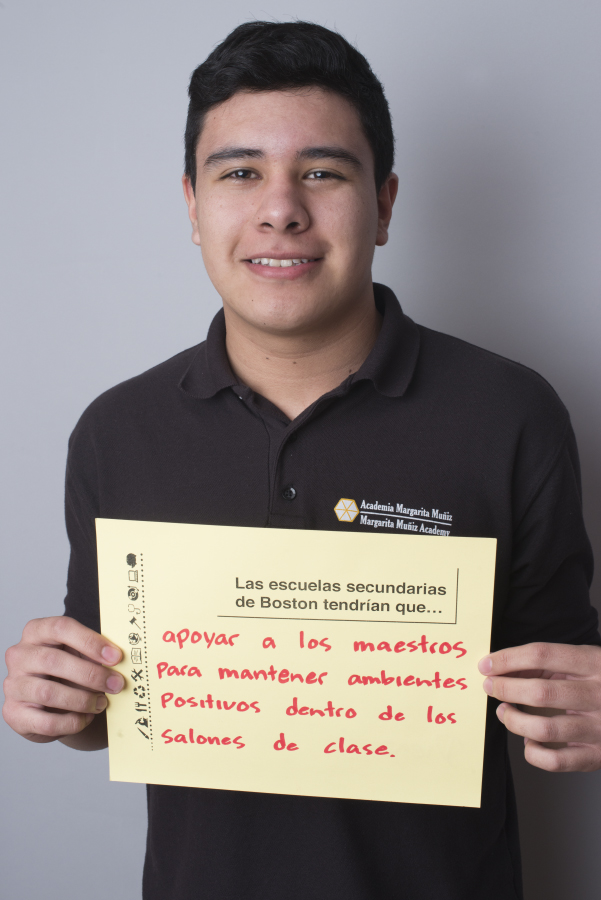
Diego Castañeda
¿Has tenido alguna vez un maestro favorito? ¿Qué recuerdas de él o de ella? ¿Te prestaba atención cuando tenías una duda? ¿Te hacía sentir cómodo dentro del salón de clases? ¿Mostraba entusiasmo cuando estaba enseñando? ¿Trataba de tener una relación positiva contigo?
Yo recuerdo a mi profesor favorito. Él mostraba siempre una actitud positiva con todos sus estudiantes y se preocupaba por la calidad del trabajo que estábamos haciendo. Lo conocía como maestro dentro de la escuela y también teníamos una relación amistosa fuera de la escuela. Cuando estaba en su clase me sentía muy cómodo. En mi opinión, este es el primer paso para que el aprendizaje suceda: cuando los estudiantes se sienten cómodos con el maestro.
También recuerdo a un maestro con el que no tenía ningún tipo de relación. La situación era rara, porque cuando llegaba a su clase solamente me sentaba en el escritorio a escucharlo por el resto de la clase. Sentía que no había ningún tipo de relación dentro del salón de clase, entonces no me importaba hacer preguntas cuando tenía alguna duda en su clase. Comparando estos casos, podemos darnos cuenta que cuando un maestro intenta tener o, de hecho, tiene una relación muy profunda con el estudiante, el aprendizaje funciona de una mejor manera.
Yo pienso que un problema es que la mayoría de maestros no tiene ningún tipo de relación con sus estudiantes.
Yo entrevisté a Dan Abramoski, el subdirector de la Academia Margarita Muñiz.
Diego: What does the Margarita Muñiz Academy Academy do differently from other schools to create positive relationships between students and teachers?
Dan: One thing that we do differently is Crew. The idea of Crew is that every student has one teacher that they can trust; that they can go to; that knows them really well; that has contact with their family. That’s a great way to build a bond between teachers and a small group of students. What happens is that students have four different Crew leaders, one for each year of high school. You see that students are still connected with their crew leaders. Sometimes when I’m talking to seniors, they talk about their ninth grade crew leader, or their tenth grade crew leader, or their eleventh grade crew leader. So they end up having four really strong relationships with four different teachers. I think that’s really important.
…Every week, all of the twelfth grade teachers meet up together to talk about students; to talk about who is struggling, who is doing well and who is having a hard time.
Another thing that is important is that almost all of our teachers are bilingual so students feel comfortable, I think, talking to teachers in whichever language they feel comfortable in. It also means that teachers can communicate with family, which helps build relationships. Also, every week, all of the twelfth grade teachers meet up together to talk about students; to talk about who is struggling, who is doing well and who is having a hard time. So every Thursday, twelfth grade teachers meet to talk about the students and say, ‘There’s this kid Diego, who’s struggling,’ and someone else will say, ‘Oh, he’s doing great in my class,’ and then they’ll say, ‘Why’s he doing so good in your class?’ ‘Oh, well, I talked to his mom, and that helped,’ or ‘Diego seems to do really well when he sits next to Brian, maybe try that,’ and the other teacher will say ‘Maybe I’ll try that. Right now he’s sitting next to this other kid.’ So we make time for teachers to think about the students as people. It’s not just about teaching and going home. There’s time in the schedule for teachers to think about who students are, and how to best teach them. That meeting is called CPT which stands for common planning time.
Diego: What are the consequences of poor student/teacher relationships?
Dan: I think the biggest consequence, and the one that I care most about, is that the students don’t learn. I think students work best when they’re comfortable and when they feel safe. And they feel comfortable and safe in the classroom when they have a good relationship with their teacher. It doesn’t mean that they have to be buddies, it just means that if there’s a relationship that they can sit down and be open to learning. You can make a mistake and know that the teacher is going to help you. You can be confused, and know the teacher is going to help you. You can ask a question and know that the teacher is going to help you. So we talk a lot about relationships between students and teachers, but I think the real reason that we talk about relationships is that we know that that is when students learn best. When the relationships aren’t great, that’s when students get in trouble. That’s when they stop learning. That’s when they get kicked out of class, and no one learns–no one likes that. It’s really about the better the relationship, the more learning takes place.
You must be logged in to post a comment.